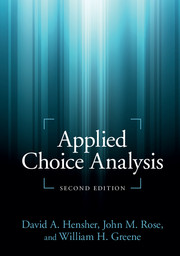Book contents
- Frontmatter
- Contents
- List of Figures
- List of Tables
- Preface
- Part I Getting started
- 1 In the beginning
- 2 Choosing
- 3 Choice and utility
- 4 Families of discrete choice models
- 5 Estimating discrete choice models
- 6 Experimental design and choice experiments
- 7 Statistical inference
- 8 Other matters that analysts often inquire about
- Part II Software and data
- Part III The suite of choice models
- Part IV Advanced topics
- Select glossary
- References
- Index
5 - Estimating discrete choice models
from Part I - Getting started
Published online by Cambridge University Press: 05 June 2015
- Frontmatter
- Contents
- List of Figures
- List of Tables
- Preface
- Part I Getting started
- 1 In the beginning
- 2 Choosing
- 3 Choice and utility
- 4 Families of discrete choice models
- 5 Estimating discrete choice models
- 6 Experimental design and choice experiments
- 7 Statistical inference
- 8 Other matters that analysts often inquire about
- Part II Software and data
- Part III The suite of choice models
- Part IV Advanced topics
- Select glossary
- References
- Index
Summary
An approximate answer to the right problem is worth a good deal more than an exact answer to an approximate problem.
(Tukey 1962)Introduction
Chapters 3 and 4 introduced a number of new concepts and models to the reader, including the probit and logit models. As seen in Chapter 4, probit and logit models are derived under different assumptions about the error term. For probit models, the error terms are assumed to be multivariate Normally distributed, while logit models assume a multivariate extreme value Type 1 distribution, or some restriction thereof. In Chapter 4, we briefly discussed the fact that discrete choice models are estimated using a method known as maximum likelihood estimation. The current chapter seeks to explain maximum likelihood estimation in the context of discrete choice models. In doing so, we also briefly discuss several of the more common algorithms used in estimating discrete choice models.
In addition to discussing maximum likelihood estimation, we also introduce the related concept of simulated maximum likelihood. A number of the models introduced in Chapter 4 do not have analytically tractable solutions when one attempts to compute their choice probabilities. Such models are said to be of open form, requiring simulation of the choice probabilities. We therefore discuss the several common simulation approaches used in estimating discrete choice models.
- Type
- Chapter
- Information
- Applied Choice Analysis , pp. 117 - 188Publisher: Cambridge University PressPrint publication year: 2015



